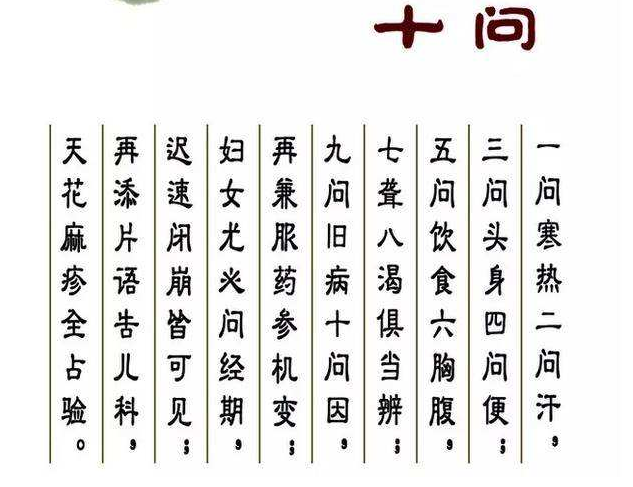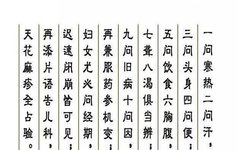For bone diseases, use Hei Bai Tong (Black Atractylodes), and for skin issues, use Huo Yang Oil!
Today, we will discuss the basic content of TCM diagnosis. Diagnosis is the most fundamental means for doctors to understand a patient’s condition. Through diagnosis, one can directly understand the causes or triggers of the illness and other related situations. Today, we will specifically introduce one part of the diagnosis process, focusing on the basic content of “symptom inquiry,” which we will discuss in three parts.

In the Ming Dynasty, Zhang Jingyue wrote in the “Complete Book of Jingyue” about the “Ten Questions,” which later became known as the “Ten Questions Song”:
“First ask about cold and heat, second ask about sweating, third ask about head and body, fourth ask about bowel movements, fifth ask about diet, sixth ask about chest and abdomen, seventh ask about deafness, eighth ask about thirst, all must be distinguished; ninth ask about old illnesses, tenth ask about causes, additionally consider medication changes, especially for women during their menstrual cycle, whether delayed or excessive bleeding can be observed, and finally add a few words for pediatrics, variola and measles are all included in the examination.”
Understanding these ten questions allows one to roughly judge the cause and urgency of the illness based on symptoms, even without going to the hospital. We will first discuss the first question regarding cold and heat. Cold and heat are the most common symptoms in clinical practice and are important criteria for determining the nature of a disease.
Here, cold and heat do not refer to the cold and heat syndromes in the Eight Principles of TCM diagnosis. Instead, the inquiry about cold and heat refers to asking the patient whether they feel cold or have a fever. The occurrence of cold and heat mainly depends on two aspects: the nature of the pathogenic factor and the balance of Yin and Yang in the body. Cold is a Yin pathogen that injures Yang Qi; when Yang Qi is insufficient, one will feel cold and sensitive to wind, indicating a cold syndrome; heat is a Yang pathogen, and when Yin is deficient and Yang is excessive, it leads to fever, hence heat syndromes are often associated with fever.
There are mainly four types of cold and heat symptoms: aversion to cold with fever, aversion to cold without fever, aversion to heat without cold, and alternating cold and heat.
Aversion to Cold with Fever (Exterior Syndrome)
This means feeling cold and having a fever, commonly seen in the early stages of external pathogenic diseases. It is an important basis for diagnosing exterior syndromes. There is a famous saying in TCM: “For every degree of aversion to cold, there is a degree of exterior syndrome.” If the aversion to cold is severe and the fever is mild, it indicates an external wind-cold phenomenon; if the fever is severe and the aversion to cold is mild, it indicates an external wind-heat phenomenon.
Aversion to Cold without Fever (Interior Syndrome)
This means feeling cold without having a fever, often resulting from excessive Yin or Yang deficiency leading to an interior cold syndrome. This can be due to a new illness or a prolonged illness causing bodily weakness.
Aversion to Heat without Cold (Interior Syndrome)
This means having a fever without feeling cold, often resulting from excessive Yang or Yin deficiency leading to an interior heat syndrome. At this time, it can be categorized into three types: high fever, tidal fever, and low fever.
High fever refers to a persistent high fever, often due to external pathogens entering the interior, causing internal Yang heat, which is mostly categorized as a real heat syndrome, presenting with symptoms such as a flushed face, profuse sweating, thirst with a preference for cold drinks, and a red tongue with a yellow coating.
Tidal fever can be divided into three situations:
The first situation is a significant fever occurring between 3 PM and 5 PM, or the fever intensifying. This is often due to internal dryness and heat in the stomach and intestines, accompanied by symptoms such as abdominal fullness and hardness, constipation, and a thick yellow dry coating;
The second situation is internal heat caused by Yin deficiency, with low-grade fever in the afternoon or at night, or accompanied by night sweats (sweating more during sleep), dry mouth and tongue, and little saliva, often due to excessive fire from Yin deficiency;
The third situation is damp-heat tidal fever, where the heat becomes significantly worse in the afternoon, with a sensation of heat that does not dissipate, and accompanied by a red tongue with a yellow greasy coating, often due to damp-heat stagnation.
Finally, low fever refers to a slight fever, ranging from 37 to 38 degrees Celsius, also known as a low-grade fever. There are many causes, such as Qi deficiency fever, Yin deficiency fever, Qi stagnation fever, and summer heat in children.
Alternating Cold and Heat (Half Exterior Half Interior Syndrome)
This refers to symptoms of alternating aversion to cold and fever, commonly seen in the following two types:
1. Alternating cold and heat without a specific time, where the patient experiences cold and heat at different times throughout the day, often several times a day without a regular pattern, usually due to the struggle between the righteous Qi and the pathogenic factor.
2. Alternating cold and heat with specific times of occurrence, where it occurs once or twice a day, often accompanied by severe headaches, body aches, thirst, and excessive sweating, commonly seen in malaria.
The above are the basic symptoms of cold and heat inquiry in the diagnosis section.
Disclaimer: This is a reprinted article; for copyright issues, please delete it. Please seek treatment under the guidance of a physician.

For bone diseases, use Hei Bai Tong (Black Atractylodes), and if you have difficulties, contact Xiang Ge.

